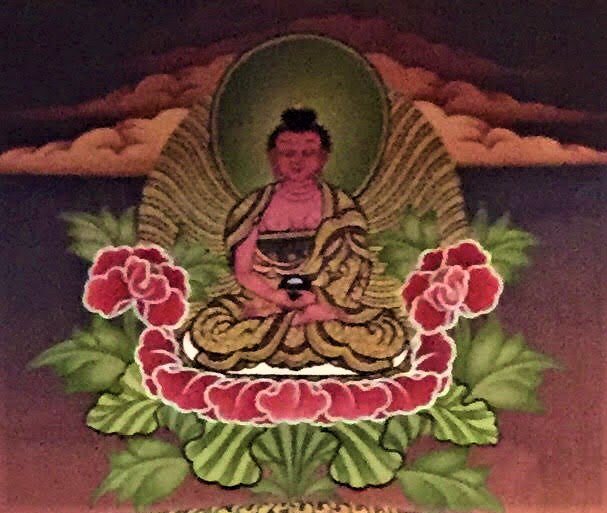Description
This beautiful Amoghasiddhi Buddha mandala with 5 Dhyani Buddhas is hand painted by the Master Artist from Bhaktapur.
Amoghasiddhi Buddha – Laughing Buddha
In the center of the mandala we can see Amoghasiddhi Buddha who is sitting in the Abhaya Mudra. This mudra symbolizes peace, protection and harmony. His green colour is symbol of happines and peace. He is also known as the Laughing Buddha.
In the first inner circle of mandala Medicine Buddha is surrounded by 8 auspicious symbols the Parasol, two golden fish, conch shell, lotus,victory banner, dharma wheel, the eternal knot, and the vase respectively.
8 Auspicious symbols and their meaning in the Mandala
- The parasol is a symbol of royal dignity and protection from the heat of the sun.
- The lotus is the symbol of mental health and spirituality.
- Golden Fishes are the symbol of good fortune, fertility and salvation. The treasure Vase is the symbol of spiritual and material abundance.
- Conch Shell is the symbol of the fame of Buddha’s teachings. Endless Knot symbolizes infinite wisdom of the Buddha.
- Victory Banner is the symbol of victory of the Buddha’s teachings and wisdom over ignorance.
- Dharmachakra or the Dharma wheel is the symbolism of the teachings of the Buddha
In the second layer there are four protector in 4 corner of the mandala. These Protectors will remove obstacles and gather all favorable conditions for their spiritual practice.
In the top most corner there are 3 Buddhas Ratnasambhava, Amitabha Buddha and Amoghasiddhi Buddha.
Ratnasambhava in Mandala
Ratnasambhava is associated with generosity.
He is sitting on a lotus platform upon a singhashan. He is yellow in colour which means “yellow Born”. He is seen in Dana mudra.
He is also associated with the Tantric rite of increase, and with prosperity generally.
Ratnasambhava is from the family called Ratna. He is holding the wish-fulfilling jewel. He holds his hands in the wish-fulfilling mudra his right hand facing down and the palm outward and his left in the mudra of meditation.
Mantra of Ratnasambhava
The mantra of Ratnasambhava is Om Ratnasambhava Tram.
Amitabha Buddha in Mandala
Amitabha Buddha, who is also called Amita or Amida Buddha, is probably the best known of the Dhyani Buddhas.
In particular, devotion to Amitabha is at the center of Pure Land Buddhism, one of the largest schools of Mahayana Buddhism in Asia.
In a long-ago time, Amitabha was a king who renounced his kingdom to become a monk. Called Dharmakara Bodhisattva, the monk practiced diligently for five eons and realized enlightenment and became a Buddha.
He is usually depicted as a bhiksu with his hands in the dhyana mudra. He is deep red in colour.
Amoghasiddhi Buddha in Mandala
Amoghasiddhi is associated with the conceptual mind. His action towards the promotion of Buddhist paths is the pacification of evils.
This is symbolised by Amoghasiddhi’s symbol, the moon. He gestures in the mudra of fearlessness, symbolising his and his devotees’ fearlessness towards the poisons or delusions.
Mantra of Amoghasiddhi
The mantra ofAmoghasiddhi is Om Amoghasiddhi Ah Hum.
Aksokbya Buddha in Mandala
In the buttom of mandala we can see medicine Aksobhya Buddha and Vairocana Buddha.
Akshobhya is blue in color. He is seen as touching the earth with his right hand. This is the earth touching mudra, which is the gesture used by the historical Buddha when he asked the earth to bear witness to his enlightenment.
In his left hand, Akshobhya holds a vajra, the symbol of shunyata an absolute reality that is all things and beings, unmanifested. Akshobhya is also associated with the fifth skandha, consciousness.
In Buddhist tantra, evoking Akshobhya in meditation helps overcome anger and hatred.
Mantra of Aksobhya
The mantra of Aksobhya is Om Aksobhya Hum.
Vairocana Buddha in the Mandala
Vairocana Buddha is white in color who is also called Primordial Buddha or Supreme Buddha. The white color represents all colors of light and all the Buddhas.
Dharma wheel is his symbol which, at its most basic, represents the study of the dharma, practice through meditation, and moral discipline. He is seen in Dharmachakra mudra . The mudra represents the turning of the wheel and places the hands so that the thumbs and index fingers touch at the tips to form a wheel.
He represents the wisdom of shunyata, or emptiness. Vairocana is considered a personification of the dharmakaya everything, unmanifested, free of characteristics and distinctions.
He is associated with the first skandha, form. Meditation on Vairocana vanquishes ignorance and delusion, leading to wisdom.
Mantra of Vairocana Buddha
The mantra of Vairocana Buddha is Om Vairocana Hum
according to Mark Unno the mantra is translated as
Praise be to the flawless, all-pervasive illumination of the great mudra. Turn over to me the jewel, lotus, and radiant light.
According to John Stevens the mantra is trenslated as
Infallible brilliance of the great mudra! Creating the radiance of the Jewel and the Lotus.















































Reviews
There are no reviews yet.